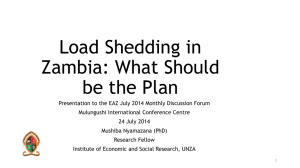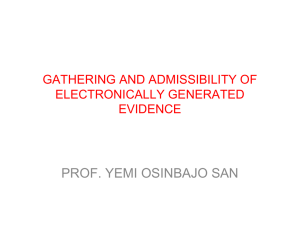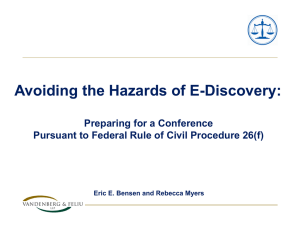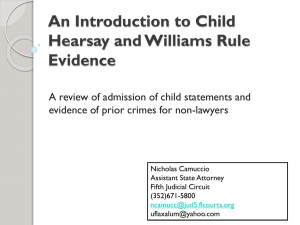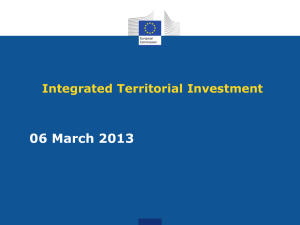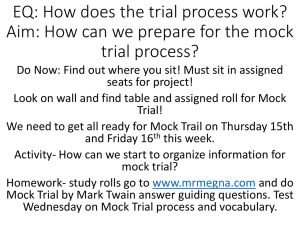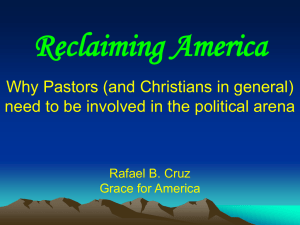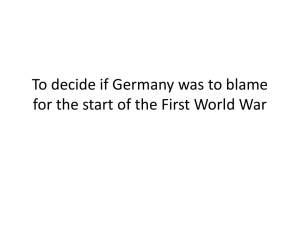A Potpourri of Evidence Issues: Admissibility of ESI
advertisement
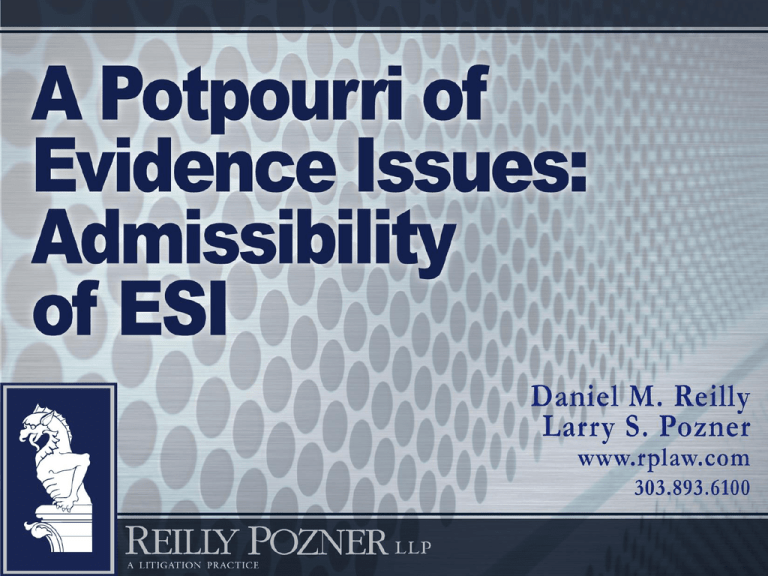
In a time of dramatic change it is the learners who inherit the future. The learned usually find themselves equipped to live in a world that no longer exists. Eric Hoffer, American Writer (1920-1983) 2 Takeaway • ESI raises distinct evidentiary issues (because it can be altered from its original form) • Traditional rules of evidence are flexible enough to deal with ESI • The evidentiary rules as applied to ESI • Suggested pre-trial procedures Metadata can be helpful in determining the authenticity of ESI • 11 Step Foundation for Computer Records • Differences between ESI and EGI and why it matters 3 I. Elements of E-Discovery 4 Definition Electronically-stored information (ESI) = “Information created, manipulated, communicated, stored, and best utilized in digital form, requiring the use of computer hardware and software.” 5 How E-Discovery is Different 1. Volume 2. Variety of sources 3. Dynamic quality 4. Hidden information: Metadata 5. Environment: Dependence and Obsolescence 6. Deleting doesn’t delete it 6 1.ESI Volume is High 95% of the world’s information is generated in digital format. 79% of American adults used the Internet in 2009. An employee at a large company will receive and send 50-100 emails daily. 7 2. Variety of Sources • Word processing documents, emails, voice mails, instant message logs, backup tapes, blogs, database files • Computer hard drives, network servers, personal digital assistants • Magnetic tapes, CD-ROMs, floppy discs, zip drives, digital phones, iPads and iPods 8 9 9 10 10 2. Variety of Sources Recent Trend: Social/Professional Networking Sites 11 2. Variety of Sources Facebook • More than 500 million active users • 50% of active users log on to Facebook in any given day • Users spend over 700 billion minutes per month on Facebook • Facebook users upload about 3 billion photos per month 12 2. Variety of Sources MySpace • More than 122 million monthly active users around the globe (70 million in US) • 100,000 signups every day • Processes 46 million activities and updates daily 13 2. Variety of Sources LinkedIn • Professional networking site • Over 75 million users • Executives from all Fortune 500 companies are LinkedIn members 14 2. Variety of Sources Twitter • Over 100 million users • 300,000 new users each day • 65 million “tweets” posted each day 15 3. Dynamic Quality • Paper documents are in effect immutable once put on paper, but … • ESI is not fixed or in a final form • Modifications can happen without human intervention and are not easily detectable • As a result, there is not always a clear original version of ESI 16 4. Hidden Information:Metadata • Definition: data about data; not readily apparent on the screen view of the file. • Information about the document that is recorded by the computer to assist in storing and retrieving. • Usually not created by or easily accessible to the computer user. 17 5. Environment: Dependence and Obsolescence • ESI can often be read only with special software. • Raw data without the special structure will appear incomprehensible • But to make comprehensible, it might lose functionality • Legacy data might have been retained, but is now difficult to access 18 6. Deleting ESI Doesn’t Delete It • Deleted or backup information may still be available, just not easily accessible. • Deleting from a hard drive is like removing a card from the card catalog – the book (the information itself) remains until it’s removed to make room for a new book. 19 II. Evidentiary Issues raised by ESI 20 Admissibility of Electronically Stored Information • Little has been written about what is required to ensure that ESI obtained in discovery will be admitted in trial • It makes little sense to go to the cost and effort to obtain ESI in discovery if a sufficient foundation cannot be established to get it admitted. 21 No Need For Special ESI Evidence Rules “We see no justification for constructing unique rules for admissibility of electronic communications such as instant messages; they are to be evaluated on a case-by-case basis as any other document to determine whether or not there has been an adequate foundational showing of their relevance and authenticity.” – In Re F.P., 878 A.2d 91, 96 (Pa. Super. Ct. 2005). 22 “In general, the Federal Rules of Evidence apply to computerized data as they do to other types of evidence. Computerized data, however, raise unique issues concerning accuracy and authenticity.” Manual for Complex Litigation (4th) § 11.446 23 “Accuracy may be impaired by incomplete data entry, mistakes in output instructions, programming errors, damage and contamination of storage media, power outages, and equipment malfunctions.” Manual for Complex Litigation (4th) § 11.446 24 Impaired Accuracy of ESI • Incomplete data entry • Mistakes in output instructions • Programming errors • Damage and contamination • Power outages • Equipment malfunctions 25 “The integrity of data may also be compromised in the course of discovery by improper search and retrieval techniques, data conversion, or mishandling.” Manual for Complex Litigation (4th) § 11.446 26 “The proponent of computerized evidence has the burden of laying a proper foundation by establishing its accuracy. The judge should therefore consider the accuracy and reliability of computerized evidence, including any necessary discovery during pretrial proceedings, so that challenges to the evidence are not made for the first time at trial.” Manual for Complex Litigation (4th) § 11.446 27 The Evidentiary Challenges Raised by ESI • The existing rules were adopted before ESI issues existed • The forms of digital and electronic evidence regularly and quickly change • Evidence can be altered from its original form 28 Evidentiary Rules Triggered By ESI • Preliminary and Conditional Rulings • Relevance • Authentication • Hearsay • Original Writing • Compare Probative Value and Risk of Prejudice 29 Evidentiary Rules (Federal) • F.R.E. 104(a) and (b) • F.R.E. 401 • F.R.E. 901(a) • F.R.E. 801, et seq. • F.R.E. 1000-1008 • F.R.E. 403 30 III. Preliminary Rulings 31 F.R.E. 104 (a) and (b) HOW THEY WORK TOGETHER • RULE 104 – Preliminary Questions (a) Questions of admissibility generally. Preliminary questions concerning the qualification of a person to be a witness, existence of a privilege, or the admissibility of evidence shall be determined by the court, subject to the provisions of subdivision (b). In making its determination it is not bound by the rules of evidence except those with respect to privileges. 32 F.R.E. 104(a) and (b) HOW THEY WORK TOGETHER RULE 104(a) • Do facts presented support preliminary admissibility? • It’s a preliminary determination of admissibility • Made by the Court • Not required to apply rules of evidence (except privilege) • Qualified by Rule 104(b) 33 F.R.E. 104 (a) and (b) HOW THEY WORK TOGETHER • RULE 104(b) Relevancy conditioned on fact. When the relevancy of evidence depends upon the fulfillment of a condition of fact, the court shall admit it upon, or subject to, the introduction of evidence sufficient to support a finding of the fulfillment of the condition. 34 F.R.E. 104(a) and (b) HOW THEY WORK TOGETHER • RULE 104(b): - Jury makes factual findings necessary to determine admissibility - The facts introduced must be admissible under rules of evidence 35 F.R.E. 104(a) and (b) HOW THEY WORK TOGETHER Example – Counsel offers E-mail into evidence • 104(a) Judge decides whether e-mail is : hearsay : an admission of party opponent : business record • 104(b) Jury decides whether e-mail is : authentic (what it purports to be) 36 IV. Authentication 37 Authenticating ESI • Arguably the biggest evidentiary challenge for ESI - Why? - Because ESI is easily created, altered, and manipulated, either accidentally or intentionally 38 Authenticating ESI • “[I]t is possible to create a Web page on a social networking site in another person’s name or to send an e-mail or post a message in another’s name. Therefore, it is difficult to show who actually is responsible for creating material on the Internet.” Levine & Swatski-Lebson, "Social Networking And Litigation," e-Commerce Law & Strategy (Jan. 2009) 39 Authenticating ESI • Authentication is a “threshold preliminary standard to test the reliability of the evidence, subject to later review by . . . cross-examination.” Lorraine v. Markel Am. Ins. Co., 241 F.R.D. 534, 544 (D. Md. 2007) 40 Authenticating ESI • Fed. R. Evid. 901(a) – proponent must offer evidence “sufficient to support a finding that the matter in question is what the proponent claims.” 41 Authenticating ESI • It’s a low hurdle – Could a reasonable juror find in favor of authenticity? United States v. Gagliardi, 506 F.3d 140, 151 (2d Cir. 2007) – Is there a rational basis for fact finder to conclude the matter is authentic? People v. Downin, 828 N.E.2d 341, 350 (Ill. Ct. App. 2005) 42 Authenticating ESI • “[T]he inability to get evidence admitted because of a failure to authenticate it almost always is a self-inflicted injury which can be avoided by thoughtful advance preparation.” Lorraine, 241 F.R.D. at 542 43 Authenticating ESI • Courts have wrestled with authentication of electronic evidence – Decisions on both sides of almost any question 44 Authenticating ESI • Best-case scenario: Stipulation – Encourage (pressure) parties to stipulate to authenticity of ESI – Often no legitimate challenge to authenticity – Saves time/money for the Court and parties 45 Authenticating ESI • Next-best alternative: Admission – Express admission (request for admission, in deposition, at trial) – Failure to object (courts generally have discretion to consider evidence where there is no objection) 46 Useful ESI Evidentiary Procedures • All ESI identified pre-trial • ESI evidence highlighted to opposing side before trial • Parties directed to stipulate where appropriate • Pre-trial offers of proof on disputed ESI exhibits • Foundational witnesses identified on ESI exhibits • Parties directed to confer to submit joint cautionary jury instructions • In camera proceedings during trial 47 ESI – In Camera 1. In camera hearing addressing authenticity does not replace the presentation of authenticating evidence before the jury. 2. The Court must revisit the authenticating evidence at trial. 3. Even though the Court may have ruled in camera that the proponent has presented sufficient evidence to support a finding that the evidence is authentic, that authenticating evidence must be presented again to the jury before the evidence may be admitted. United States v. Branch, 970 F.2d 1368 (4th Cir. 1992). 48 Authenticating ESI E-mail and electronic communication – Testimony of a witness with knowledge FRE 901(b)(1) • No special expert or computer knowledge needed (witness need not have programmed or even understand technical operation of computer) • A witness who sent or received an email can identify it as such • Other witnesses who have seen the email in electronic form can testify that it is an accurate reproduction 49 Authenticating ESI E-mail and electronic communication Comparison by trier or expert -FRE 901(b)(3) • Expert or fact finder may compare the offered document with one that has been independently authenticated. 50 Authenticating ESI E-mail and electronic communication – Comparison by trier or expert -FRE 901(b)(3) • E-mail messages “that are not clearly identifiable on their own can be authenticated . . . by comparison by the trier of fact (the jury) with . . . those e-mails that already have been independently authenticated.” - United States v. Safavian, 435 F. Supp. 2d 36, 40 (D.D.C. 2006) 51 Authenticating ESI E-mail and electronic communication – Distinctive Characteristics -FRE 901(b)(4) • Frequently used to authenticate e-mail. • Authentication based on “[a]ppearance, contents, substance, internal patterns, or other distinctive characteristics, taken in conjunction with circumstances.” • Examples: listed as sender/recipient, email address, information that only the purported sender would know, use of nicknames, etc. 52 Authenticating ESI E-mail and electronic communication – Other approaches • Technical expert to trace e-mail through servers that handled it. FRE 901(b)(9) • Technical expert to explain encryption process for encrypted emails. FRE 901(b)(9) • “Reply doctrine” – purported reply to an earlier email is likely authored by original recipient • For text messages (Short Message Service or SMS) – subpoena records kept by transmitting communications company for comparison 53 Authenticating ESI Internet Websites (print-outs) – Three steps (establish with 901(b)(1), (3), or (4)): 1. Printed page accurately reflects computer image of the website as of a certain date 2. Website is owned or controlled by a particular person or entity 3. Authorship is reasonably attributed to that person or entity 54 Authenticating ESI Internet Websites (print-outs) – Whealan v. Hartford Life & Accident Ins. Co., 2007 WL 1891175 (C.D. Cal. 2007) (court held that URL address and date stamp insufficient.) – Bowers v. Rector and Visitors of Univ. of Va., 2007 WL 2963818 (W.D. Va. 2007) (court rejected counsel’s personal affidavit which attempted to authenticate webpages) 55 Authenticating ESI Internet Websites (print-outs) – Corroboration: witness who viewed the website; internet archive (“wayback machine”) plus an expert; evidence of party’s similar postings elsewhere; 901(b)(4) evidence 56 Authenticating ESI Using the Way-Back Machine , plaintiff wishes to admit printout of the web pages of a company as they appeared years earlier. TM Ruling: Plaintiff needs an affidavit of www.archive.org representative with personal knowledge, verifying that the tendered printouts are accurate copy of Internet Archive’s (IA) records. A general affidavit of IA works is not enough. St. Luke’s Cataract & Laser Institute v. Sanderson, 2006 WL 1320242 (M.D. Fla. 2006) 57 Authenticating ESI Social Networking Sites – Essentially identical to Web page authentication – Testimony of witness with knowledge can authenticate -Adams v. Disbennett 2008 WL 4615623 – Further substantiation with technological markers (Internet address, date & time stamp, etc.) – At least one court has quashed subpoenas seeking private messages from Facebook and MySpace host companies as protected by Stored Communications Act, 18 U.S.C. §§ 2701-12. Crispin v. Christian Audigier Inc., 2010 WL 2293238 (C.D. Cal. May 26, 2010) 58 Issue Plaintiff attempts to use the metadata on relevant emails (data about data) to authenticate the emails. 59 Rule Metadata, “commonly described as ‘data about data,’ is defined as ‘information describing the history, tracking, or management of an electronic document.’” Lorraine, 241 F.R.D. at 547. 60 F.R.E. 901(b)(4) An adequate authentication can be made through the identification of distinctive characteristics, such as appearance, contents, substance, internal patterns, or other distinctive characteristics, taken in conjunction with circumstances. 61 Authenticity of Computer-stored Records (EXAMPLE) Witness testifies: 1. That the subject exhibit was printed from the company’s computer system. 2. That he knows the computer equipment is DELL equipment. 3. That he knows the name of the computer program used by the company is MS Office. 4. That he used the company’s program and the company’s computer to print out the subject exhibit. Proponent Moves: for admission of computer printout. Opponent Objects: hearsay, lack of foundation, lack of authenticity. 62 Voir Dire on Computer-stored Records It’s true that: 1. You did not enter any of the data on the printout into the computer system? 2. You do not know who did enter the data into the computer system? 3. You cannot testify as to the accuracy of the data entered into the system? 4. You do not know how the computer program works? 5. You are not the custodian of the computer records? 63 Voir Dire on Computer-stored Records (2) 6. You do not know the company’s policies or procedures for the use of the computer? 7. You do not know how access to the computer is controlled? 8. You do not know whether there have been any changes in the database or whether any such changes are logged or recorded? 9. You do not know whether the company has any type of audit program to ensure the continuing integrity of the database? 64 Eleven-step Foundation for Computer Records (a la Professor Imwinkelried) 1. The business uses a computer. 2. The computer is reliable. 3. The business has developed a procedure for inserting data into the computer. 4. The procedure has built-in safeguards to ensure accuracy and identify errors. 5. The business keeps the computer in a good state of repair. 6. The witness had the computer read out certain data. 7. The witness used the proper procedures to obtain the readout. 8. The computer was in working order at the time the witness obtained the readout. 9. The witness recognizes the exhibit as the readout. 10. The witness explains how he or she recognizes the readout. 11. If the readout contains strange symbols or terms, the witness explains the meaning of the symbols or terms for the trier of fact. Imwinkelried, Evidentiary Foundations § 4.03 [2]. 65 V. Hearsay 66 Hearsay • Four Steps to Evaluating ESI Hearsay – Is it a “statement” by a “declarant”? – Is it offered for its truth? – Is it excluded from hearsay by 801(d)? • Prior statement of testifying witness • Admission by party opponent – Is there an applicable exception? 67 Hearsay - statement by declarant? • Statement = (1) oral or written assertion or (2) nonverbal conduct of a person intended as assertion. Fed. R. Evid. 801(a) • Declarant – must be a person. Fed. R. Evid. 801(b) 68 Hearsay - statement by declarant? • Important distinction: Electronically stored v. electronically generated information – Not always recognized by courts – United States v. Blackburn, 992 F.2d 666 (7th Cir. 1993) (court assumed computergenerated printout was hearsay but found it admissible under hearsay exception) 69 Hearsay - statement by declarant? “[N]othing ‘said’ by a machine . . . is hearsay.” United States v. Washington, 498 F.3d 225, 231 (4th Cir. 2007) (quoting 4 Mueller & Kirkpatrick, Federal Evidence § 380 (2d ed. 1994)). 70 Hearsay - statement by declarant? – Electronically stored information = humancreated, stored electronically • May be hearsay • Examples: – – – – Email text Letters and other word processing documents Social network messages or posts “Facebook messages raises issues of hearsay.” Maldonado v. Municipality of Barceloneta, 2009 U.S. Dist. LEXIS 19842 at *2 n.2 (DPR 2009) – Chat room conversations – Text messages 71 Hearsay - statement by declarant? – Electronically generated information = created by a computer process or system • Examples: – – – – Most metadata Email headers GPS data A fax machine generated report of transmission A list of calls made from a cellphone showing time of call, phone number called, length of call. 72 Hearsay - statement by declarant? – Some electronic information is a mixture of electronically stored and electronically generated information • Spreadsheets with automatic calculations • Chat room logs • Emails with content and header – This “mixed” information implicates hearsay rules, at least as to the human-generated statements 73 The Threshold Issue of Admissibility of EGI: • Is it exempt from the hearsay rule? • Is it hearsay? • Does it fall within a hearsay exemption? 74 Argument why EGI is not hearsay: • It is not a statement of a person Argument why EGI is hearsay: • It is an out-of-court statement (of a machine) being introduced to prove the matter asserted. 75 Issue • The theory that EGI is not hearsay is not based on a notion that it is more reliable than other types of information. • In fact, if no person is required to testify to its creation, who is cross-examined on the broad issues of reliability? 76 If EGI is Treated as Non-hearsay: • It is treated as if it is trustworthy, when it may not be. • It escapes the gate-keeping function of hearsay rules. • EGI thereby becomes a prime candidate for E-discovery. • It becomes admissible against a person or corporation that may not have created it even known or was created. • Note: Statements must still be reliable under authentication rules (e.g., product of a system capable of producing reliable result) 77 Issue If EGI is treated as hearsay: • It is the machine that is the Declarant • Who should be the witness? • A person knowledgeable about how this computer compiled and generated this information? • The software or a software programmer who created the instructions allegedly followed by the machine? • A person from the business or home who has possession of the document? • “Nobody” treated as hearsay within the business record or treated as a business record? 78 Problems with Using the Business Records Exception to Admit EGI Against a Party: • The party did not create the EGI • The party may not have even known it was created • The machine’s programming was created by a non-agent non-employee not responsible to the party • The record is often not knowingly kept by the business • The EGI may serve no business purpose 79 EGI is an Admission Under: Application of 801(d)(2) • While a party’s e-mail might come in as a statement against interest, why would that apply to a computer-generated information? (A) Not the party’s statement; or (B) Party has not necessarily adopted it; or (C) Not made by a person authorized to make that statement; or (D) Not made by a party’s agent? 80 If we treat the machine as a Declarant, why should the machine’s “testimony” be attributed to its owner? • The owner had virtually zero to do with the creation of data or software. • The owner cannot be said to be responsible for the information – the machine is not his agent or employee. • If the computer is not the Declarant of EGI, there is no statement of a witness. What is the admissibility based on? 81 Are we ready to call our computers our agents? 82 Hearsay – ESI Exceptions • Business Records Exemption – Fed. R. Evid. 803(6) – Record must be (1) contemporaneously made and (2) kept in the normal and ordinary course of business • Must relate to the business, not the individual’s personal use – Note: the actual physical printout can be created in anticipation of litigation; the exemption refers to the underlying data 83 Hearsay – ESI Exceptions • Business Records Exemption – Caveat – “unless the source of the information or the method or circumstances of preparation indicate lack of trustworthiness” • Easily overlooked • Must show reliability of the system producing the information 84 Issue E-mail chains as business records. F.R.E. 803(6) Plaintiff offers e-mail chain. Witness says its his regular practice to send an e-mail summarizing phone calls he receives. No showing that it was the regular practice of the employer to require that the employee make and maintain such e-mails. No testimony that this was the practice of all others in the chain. 85 How would you rule? • What if the source of the original information was an outsider? 86 New York v. Microsoft Corp., 2002 WL 649951 (D.D.C. 2002) • Analyzed the admissibility of series of exhibits including e-mail and e-mail “chains” under various hearsay exceptions, and ruling that an e-mail prepared several days after a telephone call that described the call did not qualify as a present sense impression under Rule 803(1) because the requirement of “contemporaneity” was not met. 87 Rambus, Inc. v. Infineon Techs. AG, 348 F.Supp.2d 698 (E.D. Va. 2004) (each participant in an e-mail chain must be acting in the course of regularly conducted business) 88 In contrast to the demanding approach taken in Rambus and New York v. Microsoft, the court in United States v. Safavian took a more flexible approach to the admissibility of e-mail chains. 435 F.Supp.2d 36, 40-41 (D.D.C.2006). The defendant objected to the admissibility of e-mail chains, arguing that they were not trustworthy because they contained e-mails embedded within emails. The court overruled this objection, stating: “[t]he defendant’s argument is more appropriately directed to the weight the jury should give the evidence, not its authenticity. While the defendant is correct that earlier e-mails that are included in a chain-either as ones that have been forwarded or to which another has replied-may be altered, this trait is not specific to e-mail evidence. It can be true of any piece of documentary evidence, such as a letter, a contract or an invoice. . . . The possibility of alteration does not and cannot be the basis for excluding e-mails as unidentified or unauthenticated as a matter of course. . . . We live in an age of technology and computer use where e-mail communication now is a normal and frequent fact for the majority of the nation’s population and is of particular importance in the professional world. . . . Absent specific evidence showing alteration, however, the Court will not exclude any embedded e-mails because of the mere possibility that it can be done.” 89 Hearsay – ESI Exceptions • Public Records Exemption – Fed. R. Evid. 803(8) – Documents prepared by public office or agency deemed trustworthy – Particularly important as to information from government websites 90 Hearsay – ESI Exceptions • Present Sense Impression, Excited Utterance, or Then-Existing Condition – Fed. R. Evid. 803(1), (2), and (3) – Particularly important as to social networking messages and text messages • [We should be able to find some good Facebook or Twitter examples for this] 91 Summary • ESI raises distinct evidentiary issues (because it can be altered from its original form) • Traditional rules of evidence are flexible enough to deal with ESI • The evidentiary rules as applied to ESI • Suggested pre-trial procedures Metadata can be helpful in determining the authenticity of ESI • 11 Step Foundation for Computer Records • Differences between ESI and EGI and why it matters 92
